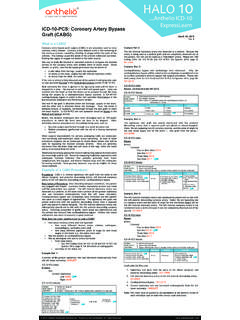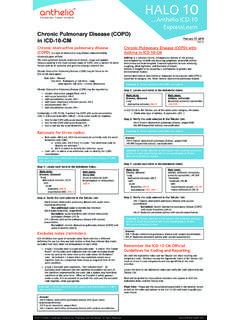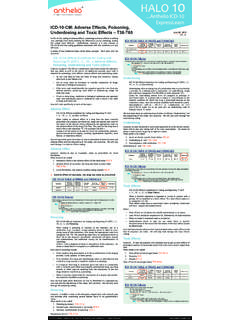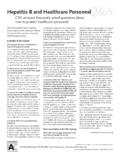Transcription of Anthelio ICD-10 ExpressLearn ICD-10-PCS: …
1 HALO 10.. Anthelio ICD-10 . ExpressLearn ICD-10 -PCS: percutaneous transluminal cardiac angioplasty (PTCA) March 05, 2015. Vol. 7. What is a PTCA? Example Part 1: percutaneous transluminal coronary angioplasty (PTCA) is a minimally invasive The obtuse marginal revealed only minimal disease requiring only procedure to open up blocked coronary arteries, allowing blood to circulate angioplasty which was accomplished by balloon which was positioned and unobstructed to the heart muscle. The procedure begins with the doctor inflated to 6 atmospheres for 15 seconds and then deflated. 02703ZZ. injecting local anesthesia into the groin area and putting a needle into the ICD-10 -PCS Index femoral artery. A guide wire is placed through the needle and the needle is removed. This is the percutaneous approach to the heart and great vessels. Dilation Artery An introducer is then placed over the guide wire, after which the wire is Coronary removed. A different sized guide wire is put in its place.
2 Next, a diagnostic Four or More Sites 0273. catheter is advanced through the introducer over the guide wire, into the One Site 0270. blood vessel. This catheter is then guided to the aorta and the guide wire is removed. Once the catheter is placed in the opening of one the coronary Three Sites 0272. arteries, the doctor injects dye and takes an image. Two Sites 0271. ICD-10 -PCS Tabular If a treatable blockage is noted, the first catheter is exchanged for a guiding catheter. Once the guiding catheter is in place, a guide wire is advanced Section 0 Medial and Surgical across the blockage, and then a balloon catheter is advanced to the blockage Body System 2 Heart and Great Vessels site. The balloon is inflated for a few seconds to compress the blockage Operation 7 Dilation: Expanding an orifice or the lumen of a tubular body part against the artery wall. Then the balloon is deflated. The PTCA is coded to the Root Operation: Dilation. [Dilation - Definition: Expanding an orifice or the Body Part Approach Device Qualifier lumen of a tubular body part.]
3 ] The doctor may repeat this a few times, each 0 Coronary Artery, One Site 4 Intraluminal Device, Drug- time increasing the pressure a little more to widen the passage for the blood 1 Coronary Artery, Two Sites 0 Open eluting 6 Bifurcation 3 percutaneous to flow through. 2 Coronary Artery, Three Sites 4 percutaneous D Intraluminal Device Z No Qualifer 3 Coronary Artery, Four or More T Intraluminal Device, Endoscopic Sites This treatment may be repeated at each blocked site in the coronary arteries. Radioactive Z No Device [The coronary arteries are classified as a single body part that is further specified by number of sites treated and not by name or number of arteries. Separate body part values are used to specify the number of sites treated Example Part 2: when the same procedure is performed on multiple sites in the coronary arteries.] A stent may be placed within the coronary artery to keep the vessel A drug-eluting stent was deployed to the proximal-mid LAD, covering the open.
4 If a stent is place it is considered to be a Device. [A device is coded entire moderately diseased proximal site and post dilator with balloon up to only if a device remains after the procedure is completed.] Once the 15 atmospheres. This resulted in a fully deployed stent with no evidence of compression has been performed, contrast media is injected and an image is dissection, thrombosis or distal embolization. 027034Z. taken to check for any change in the arteries. Following this, the catheter is removed and the procedure is completed. ICD-10 -PCS Index Example: Dilation Artery Procedure: PTCA of proximal-mid left anterior descending artery and obtuse Coronary marginal with insertion of a drug-eluting stent of the proximal-mid left Four or More Sites 0273. anterior descending (LAD) coronary artery One Site 0270. Description of Procedure: The patient was brought to the procedure room Three Sites 0272. and prepped and draped in the sterile fashion. The right femoral artery was Two Sites 0271.
5 Accessed and a French guide catheter and wire were used. Immediately after the origin of the large diagonal branch, there was about 80% LAD disease. Mid ICD-10 -PCS Tabular and distal LAD otherwise appeared to be unremarkable. Section 0 Medial and Surgical 1. The obtuse marginal revealed only minimal disease requiring only Body System 2 Heart and Great Vessels angioplasty which was accomplished by balloon which was positioned and Operation 7 Dilation: Expanding an orifice or the lumen of a tubular body part inflated to 6 atmospheres for 15 seconds and then deflated. 2. A drug-eluting stent was deployed to the proximal-mid LAD, covering the Body Part Approach Device Qualifier entire moderately diseased proximal site and post dilator with balloon up 0 Coronary Artery, One Site 0 Open 4 Intraluminal Device, Drug- 1 6 Bifurcation to 15 atmospheres. This resulted in a fully deployed stent with no Coronary Artery, Two Sites 3 percutaneous eluting Z No Qualifer 2 Coronary Artery, Three Sites D Intraluminal Device 4 percutaneous evidence of dissection, thrombosis or distal embolization.
6 3 Coronary Artery, Four or More Endoscopic T Intraluminal Device, Sites Radioactive Guide catheter and wires were removed. Left femoral arterial sheath was Z No Device removed. Patient tolerated procedure well. What does the coder need to know to code a Final codes for PTCA of proximal-mid left anterior descending artery and PTCA? obtuse marginal with insertion of a drug-eluting stent of the proximal-mid left anterior descending (LAD) coronary artery . The root operation is a Dilation angioplasty of the obtuse marginal coronary artery: 02703ZZ. The body part being dilated is coronary arteries How many coronary arteries are being dilated angioplasty of the proximal-mid left anterior descending (LAD). What is the approach? coronary artery with drug eluding stent: 027034Z. Is a stent (device) being used? Note: The coder must be guided by documentation in the medical record of Is every artery being treated receiving a stent? each individual case to make the correct code selections.
7 Is the stent drug eluding or non-drug eluding? Is the procedure being performed on a bifurcation? 2015 Anthelio Healthcare Solutions Inc. Proprietary and confidential. All Rights Reserved.














